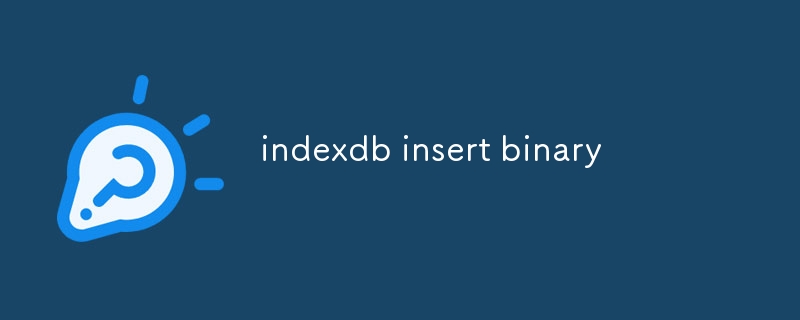indexdb插入二进制
本文提供了如何高效地将二进制数据插入 IndexedDB 的全面指南。它概述了将二进制数据转换为数组缓冲区、创建对象存储、事务和对象、设置对象的

如何有效地将二进制数据插入 IndexedDB 的分步说明?
IndexedDB 是一个强大的数据存储API,可用于存储各种类型的数据,包括二进制数据。要高效地将二进制数据插入 IndexedDB,请按照以下步骤操作:
1.将二进制数据转换为数组缓冲区: IndexedDB 使用 ArrayBuffer 对象,因此您需要首先将二进制数据转换为数组缓冲区。您可以使用 ArrayBuffer.from() 方法来实现此目的。ArrayBuffer.from() method for this purpose.
2. Create a new IndexedDB object store: An object store is a container for data in IndexedDB. You need to create a new object store to store your binary data.
3. Create a new IndexedDB transaction: A transaction is a unit of work in IndexedDB. You need to create a new transaction to insert your binary data.
4. Create a new IndexedDB object: An object is a representation of a record in IndexedDB. You need to create a new object to store your binary data.
5. Set the value of the object to the array buffer: The value of an object can be set to an array buffer. Set the value of your object to the array buffer that you created in step 1.
6. Add the object to the object store: Add the object to the object store that you created in step 2.
7. Commit the transaction: Once you have added the object to the object store, you need to commit the transaction to save the changes.
Example:
// Create an array buffer from binary data
const buffer = ArrayBuffer.from(binaryData);
// Create a new object store
const store = db.createObjectStore("myBinaryData", { keyPath: "id", autoIncrement: true });
// Create a transaction
const transaction = db.transaction(["myBinaryData"], "readwrite");
// Create a new object
const object = transaction.objectStore("myBinaryData").create({});
// Set the value of the object to the array buffer
object.value = buffer;
// Add the object to the object store
transaction.objectStore("myBinaryData").add(object);
// Commit the transaction
transaction.commit();Can I use IndexedDB to store images as binary objects?
Yes, you can use IndexedDB to store images as binary objects. To store an image as a binary object in IndexedDB, follow these steps:
1. Read the image file as an array buffer: Use the FileReader
2.创建一个新的 IndexedDB 对象存储: 对象存储是 IndexedDB 中数据的容器。您需要创建一个新的对象存储来存储二进制数据。
3.创建一个新的 IndexedDB 事务: 事务是 IndexedDB 中的一个工作单元。您需要创建一个新交易来插入二进制数据。
4.创建一个新的 IndexedDB 对象:
对象是 IndexedDB 中记录的表示。您需要创建一个新对象来存储二进制数据。5.将对象的值设置到数组缓冲区:
可以将对象的值设置到数组缓冲区。将对象的值设置为您在步骤 1.6 中创建的数组缓冲区。将对象添加到对象存储:
将对象添加到您在步骤 2 中创建的对象存储。7.提交事务:
将对象添加到对象存储后,您需要提交事务以保存更改。示例:
🎜rrreee🎜我可以使用 IndexedDB 将图像存储为二进制对象吗?🎜🎜🎜是的,您可以使用 IndexedDB 将图像存储为二进制对象。🎜 要将图像存储为 IndexedDB 中的二进制对象,请按照以下步骤操作:🎜🎜🎜1.将图像文件作为数组缓冲区读取:🎜 使用FileReader API 将图像文件作为数组缓冲区读取。🎜🎜🎜2.将数组缓冲区转换为 Base64 字符串:🎜 IndexedDB 不支持直接存储数组缓冲区。在将数组缓冲区存储到 IndexedDB 之前,您需要将其转换为 Base64 字符串。🎜🎜🎜3。将base64字符串插入IndexedDB:🎜使用上一节中概述的步骤将base64字符串插入IndexedDB。🎜🎜在IndexedDB中存储二进制数据有哪些限制?🎜🎜🎜在IndexedDB中存储二进制数据有一些限制: 🎜🎜🎜🎜1.大小限制:🎜 IndexedDB 每个数据库的大小限制为 2^31-1 字节。这意味着您不能在单个 IndexedDB 数据库中存储超过 2 GB 的二进制数据。🎜🎜🎜2.性能:🎜 在 IndexedDB 中存储二进制数据可能比存储其他类型的数据(例如字符串或数字)慢。这是因为 IndexedDB 在存储之前需要将二进制数据转换为 Base64 字符串,这可能是一个耗时的过程。🎜🎜🎜3.兼容性:🎜 IndexedDB 并非所有浏览器都支持。这意味着您可能无法在所有浏览器中使用 IndexedDB 存储二进制数据。🎜以上是indexdb插入二进制的详细内容。更多信息请关注PHP中文网其他相关文章!

热AI工具

Undresser.AI Undress
人工智能驱动的应用程序,用于创建逼真的裸体照片

AI Clothes Remover
用于从照片中去除衣服的在线人工智能工具。

Undress AI Tool
免费脱衣服图片

Clothoff.io
AI脱衣机

Video Face Swap
使用我们完全免费的人工智能换脸工具轻松在任何视频中换脸!

热门文章

热工具

记事本++7.3.1
好用且免费的代码编辑器

SublimeText3汉化版
中文版,非常好用

禅工作室 13.0.1
功能强大的PHP集成开发环境

Dreamweaver CS6
视觉化网页开发工具

SublimeText3 Mac版
神级代码编辑软件(SublimeText3)




